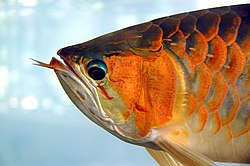
Back Barbelló (anatomia) Catalan Barteln German Bigote (anatomía) Spanish Poised ET Bizar (anatomia) EU سبیلک FA Viiksisäie Finnish Barbillon French בין (אנטומיה) HE Barbiglio Italian


In fish anatomy and turtle anatomy, a barbel is a slender, whiskerlike sensory organ near the mouth. Fish that have barbels include the catfish, the carp, the goatfish, the hagfish, the sturgeon, the zebrafish, the black dragonfish and some species of shark such as the sawshark. Barbels house the taste buds of such fish and are used to search for food in murky water.
The word barbel comes from Latin barbula 'little beard'.[1] Barbels are sometimes erroneously referred to as barbs, which are found in bird feathers for flight.
Barbels may be located in a variety of locations on the head of a fish. "Maxillary barbels" refers to barbels on either side of the mouth. Barbels may also be nasal, extending from the nostrils. Also, barbels are often mandibular or mental, being located on the chin.
In fish, barbels can take the form of small, fleshy protrusions or long, cylindrical shaped extensions of the head of a fish. The cylindrical barbel shapes are built on an internal support system that can be made from ossified tissue or from cartilaginous connective tissue that provides a base for blood vessels and myelinated nerves to wrap around, held together in the dermis.[2] Muscle tissue in the central region of the barbel allows the structure limited movement that aids in prey manipulation. On the epidermis, taste buds are situated on dermal papillae, small ridges of folded skin that increase the surface area of the skin and the total number of taste buds that can be concentrated on the barbel.[2] Concentrations of taste buds vary from species to species, with bullhead catfish having 25 buds in a square millimeter of barbel skin.[3]
Barbels begin to develop during the embryonic, larval, or juvenile life stages of most of the species in which they are present. Development regulation of barbels has been linked to the C-C motif ligand 33 of the chemokine family of genes, due to its presence in barbeled catfish and zebrafish and absence or difference in expression in barbel-less members of the same families.[4] This class of genes are signalling genes that provide migrating cells directional information during morphogenesis.
- ^ "barbel". American Heritage Dictionary. Retrieved 9 April 2018.
- ^ a b Fox, Harold (May 1999). "Barbels and barbel-like tentacular structures in sub-mammalian vertebrates: a review". Hydrobiologia. 403: 153–193. Bibcode:1999HyBio.403..153F. doi:10.1023/A:1003778125517. S2CID 45206327.
- ^ von der Emde, Gerhard; Mogdans, Joachim; Kapoor, B. G., eds. (2004). The Senses of Fish. doi:10.1007/978-94-007-1060-3. ISBN 978-94-010-3779-2. S2CID 36978815.
- ^ Zhou, Tao; Li, Ning; Jin, Yulin; Zeng, Qifan; Prabowo, Wendy; Liu, Yang; Tian, Changxu; Bao, Lisui; Liu, Shikai; Yuan, Zihao; Fu, Qiang (2018-05-29). "Chemokine C-C motif ligand 33 is a key regulator of teleost fish barbel development". Proceedings of the National Academy of Sciences. 115 (22): E5018 – E5027. Bibcode:2018PNAS..115E5018Z. doi:10.1073/pnas.1718603115. ISSN 0027-8424. PMC 5984497. PMID 29760055.